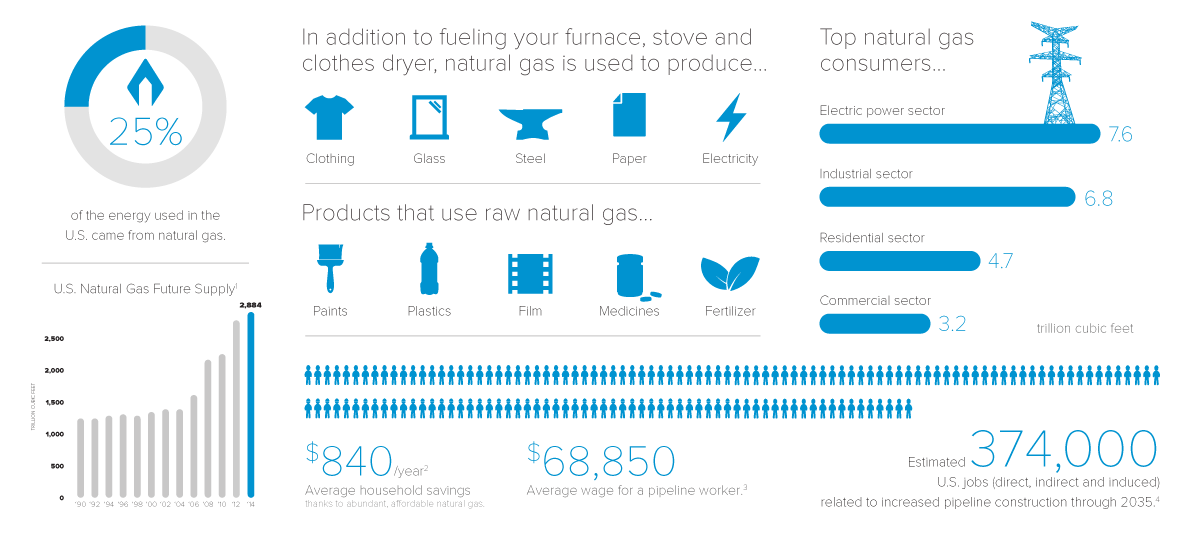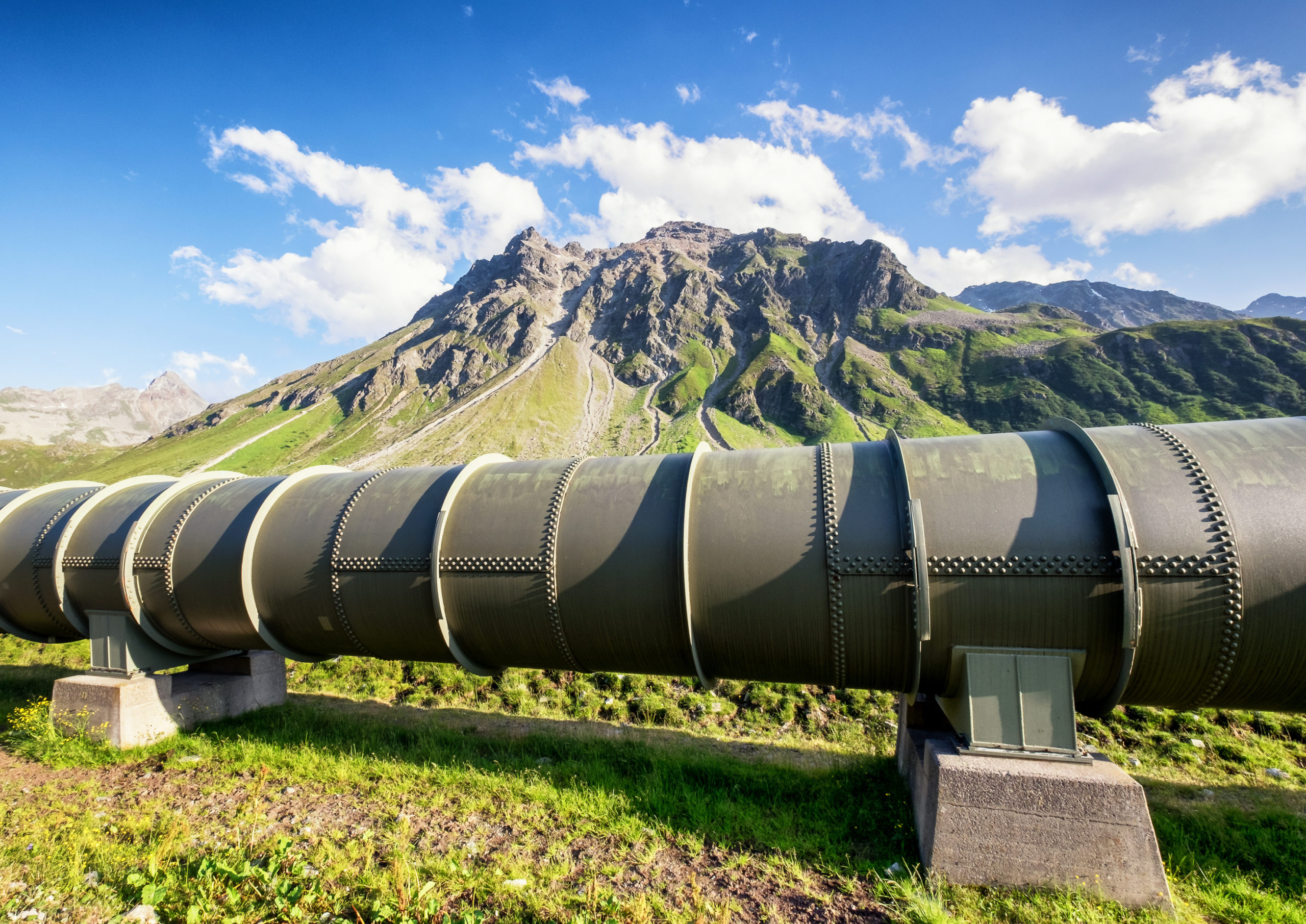Economics
Natural gas touches everyone’s lives, often in ways that people aren’t aware of. While most people think of their furnaces and stoves when they hear the term “natural gas,” the fuel heats homes, generates 30 percent of the nation’s electricity, is a key component of the fertilizer that helps grow our crops, and is used by manufacturers to make a wide range of products, such as trash bags, lipstick, and toys. Pipelines make the use of natural gas possible by delivering the gas safely and reliably across the country.

Consumers and producers alike have benefited from the recent boom in domestic natural gas. Gas now provides roughly 25 percent of the energy used in the United States, and power plants, factories, and homeowners alike benefit from its reliability and affordability. Even as the country and world shift to more renewable resources of energy, natural gas is poised to remain a long-term part of the clean, reliable, and affordable energy mix.
The growth in domestic production is also fueling America’s economy through job growth. Abundant natural gas is creating thousands of jobs in the production and pipeline sector and has been a driving force behind the past decade’s resurgence of the U.S. manufacturing sector.
98 percent of the natural gas used in the U.S. comes from North America. INGAA members operate over 202,000 miles of natural gas pipelines. That’s enough to wrap around the earth more than eight times!
If all the 2.2 million miles of natural gas pipelines in the U.S. were connected to each other they would stretch to and from the moon almost nine times.
Yes. Pipelines are the safest, most reliable and efficient manner of transporting energy products.
The Department of Transportation, or DOT, oversees interstate natural gas pipelines, and they often note that pipelines are the safest form of energy transportation. Statistics gathered by the National Transportation Safety Board, a federal agency, indicate that pipelines make up less than one one-hundredth of one percent (.01%) of all transportation accidents in the United States. There are approximately 300,000 miles of natural gas transmission pipelines throughout the United States that deliver safe, reliable natural gas to American families and businesses.
Pipelines exist almost everywhere throughout the United States -generally buried underground – transporting the energy that you depend on every day to heat your home, generate electricity, cook your food and so much more. Pipelines are a vital and efficient part of the United States’ energy infrastructure.
The following are a few of the agencies that regulate natural gas pipelines:
The Federal Energy Regulatory Commission (FERC) regulates such things as natural gas transportation rates, pipeline capacity, pipeline siting and natural gas quality requirements.
The U.S. Department of Transportation (DOT) Pipeline and Hazardous Materials Safety Administration (PHMSA) and their state and local agents provide regulation for the safe transportation of natural gas through pipelines.
The U.S. Environmental Protection Agency (EPA), the Fish and Wildlife Service and state environmental protection agencies provide regulations for protection of the environment and cultural resources during the construction and operation of pipeline facilities.
The U.S. Occupational Safety and Health Administration (OSHA) provides regulation for the safe working place for personnel.
Natural gas pipeline easements have had little or no effect on property values historically.
Integra Realty Resources, a leading provider of real estate valuation and counseling services, conducted a rigorous study of properties in four separate areas of the country in 2015. The report, Pipeline Impact to Property Value and Property Insurability, prepared on behalf of the INGAA Foundation, shows that the presence of pipelines does not affect the value of a property, its insurability, its desirability or the ability to obtain a mortgage.
The Federal Energy Regulatory Commission is charged by Congress with evaluating whether interstate natural gas pipeline projects proposed by private companies should be approved. The federal government does not propose, construct, operate, or own such projects. The commission’s determination whether to approve such a project may affect you if your land is where a natural gas pipeline, other facilities, or underground storage fields might be located. FERC has issued a handy guide, An Interstate Natural Gas Facility on My Land? What Do I Need to Know?, for your information.
This guide covers:
How the Federal Energy Regulatory Commission’s procedures work;
What rights landowners have;
How the location of a pipeline or other facilities is decided;
What safety and environmental issues might be involved.
INGAA’s members live and work in these communities where projects are built and have committed to having a long-term relationship as your neighbor. INGAA members affirmed its commitments to landowners in a document called ‘America’s Natural Gas Transporters’ Commitment to Landowners.’
Yes. Any land disturbance for pipeline construction is temporary. Pipeline construction crews work to restore the land to its previous state. With the exception of pipeline safety markers located at each crossing of a public road and railroad and anywhere else necessary to identify the location of a pipeline, underground gas pipelines are largely invisible as they transport energy.
After a line is built, you can carry on normal farming operations, including crop growing and grazing. And because pipelines have at least 36 inches of soil cover, there should be no obstacles to normal irrigation or cultivation. You cannot plant trees on pipeline rights-of-way, nor can you build homes or business facilities. These restrictions are in place for safety and for pipeline maintenance purposes. They also may affect the value of the land, which will be reflected in the compensation that the landowner receives from the pipeline company.
After construction of the pipeline, the company will periodically inspect the site to ensure it is being properly maintained. Inspections are done from airplanes as well as on foot. It is the responsibility of the pipeline company to maintain the site, through such activities as mowing fields and clearing trees. These maintenance activities help the company properly inspect the site.
As the cleanest of all fossil fuels, natural gas is quickly becoming the fuel of choice for the future. It also is safe, inexpensive and easily available in many places around the United States. These qualities are helping to boost consumer demand, which at more than 22 trillion cubic feet per year is an all-time high.
The U.S. Energy Information Administration (EIA) estimates that demand for natural gas will reach 30 Tcf by 2012. This means that the natural gas pipeline industry must respond with more facilities to supply the additional demand for natural gas.






